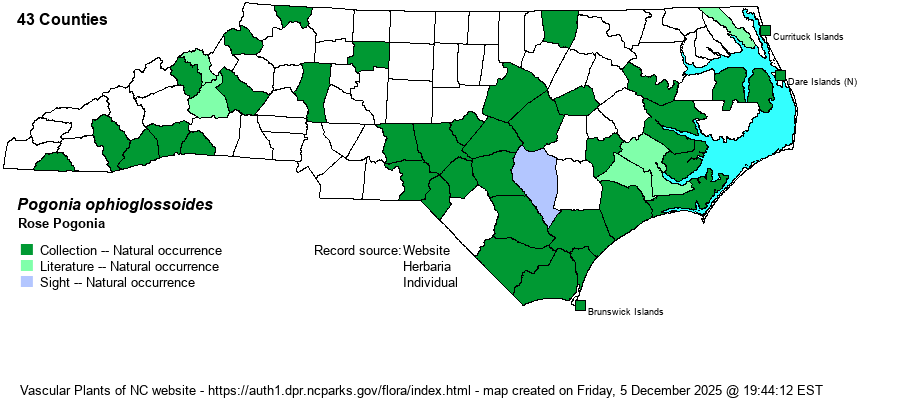| Author | (L.) Ker-Gawler | |
| Distribution | Widely distributed across the state, though primarily found in the southern half of the Coastal Plain, from the Sandhills east to Beaufort and Carteret counties. Scattered over most of the Mountains and Piedmont, with gaps. Apparently absent from much of the northern Coastal Plain, although large populations may be seen in peaty roadside bogs in Dare and Tyrrell counties.
This is a wide-ranging orchid, occurring from Newf. to Man. south to most of FL and eastern TX. However, it has a somewhat bimodal range, being widespread from NJ and MN northward, and then southward mostly in the Coastal Plain -- being very scarce in the center and west-center of the range. | |
| Abundance | Uncommon to locally fairly common in the southern half of the Coastal Plain, including the Sandhills. Rare in the Mountains, more so in the southern counties near SC. Very rare (with local exceptions) in the northern Coastal Plain, Piedmont, and most of the northern Mountains. | |
| Habitat | This species has a wide array of wet to damp and +- open habitats. It is most frequent in wet savannas, seepages, streamhead ecotones, wet margins of ponds, pools, and even in ditches and in scrapes within flatwoods. It also occurs in bogs in the Mountains. Though it does occur in savannas, it favors wetter portions/conditions than most other orchids such as the Calopogon and Platanthera species. | |
| Phenology | Blooms mainly in May and June, and fruits shortly after blooming. | |
| Identification | This is one of the shorter orchid species, often just 6-12 inches tall. Thankfully, its single flower (rarely two or three) is large for the size of the stem, it being a bright pink in color and about 1-1.5 inches across. The lip is strongly fringed. There are a few ascending to erect stem leaves. It usually grows in small colonies, and more than likely when you run across one individual you will encounter several to many others nearby. Though it is a short species, thankfully it tends to grow in wet enough places that it usually does not get shaded out by taller vegetation. As it is the sole species in its genus, there are no other wildflowers like it, so it is easily identified at first glance by the roughly triangular shape of the bright pink flower. | |
| Taxonomic Comments | None
| |
| Other Common Name(s) | Snakemouth Orchid | |
| State Rank | S3 | |
| Global Rank | G5 | |
| State Status | | |
| US Status | | |
| USACE-agcp | OBL link |
| USACE-emp | OBL link |

